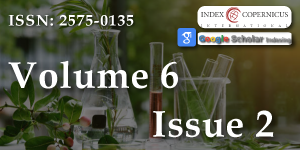Chemical composition of olive stems essential oil from Ethiopia
Main Article Content
Abstract
In this article, the chemical compounds, antimicrobial and antioxidant activity of the volatile oil from leaves of Olea Europaea L. cultivar from Ethiopia has been studied. The essential oil was provided with a dry distillation apparatus and analyzed by GC-MS/FID. This analysis leads to the detection of 128 compounds representing 89.4% of the total oil. The major constituents were methyl ester hexadecanoic acid (4.10%), 2,4-dimethoxyphenolAa (4.05%), 2-methoxy-phenol (3.25%), 3,5-dimethoxy-4-hydroxytoluene (3.20%), 2-methoxy-5-methyl phenol (3.19%), 1,2,3-trimethoxy-5-methyl benzene (2.93%), 2-methoxy-4-vinyl phenol (2.70%), 2-hydroxy-3-methyl-2-cyclopenten-1-one (2.60%), trans-Isoeugenol (2.45%) and (E) -2,6-dimethoxy-4- (prop-1-en-1-yl) phenol (2.25%). The composition of essential oils was dominated by phenolic compounds.
Article Details
Copyright (c) 2022 Asfaw MD.

This work is licensed under a Creative Commons Attribution 4.0 International License.
The Journal of Plant Science and Phytopathology is committed in making it easier for people to share and build upon the work of others while maintaining consistency with the rules of copyright. In order to use the Open Access paradigm to the maximum extent in true terms as free of charge online access along with usage right, we grant usage rights through the use of specific Creative Commons license.
License: Copyright © 2017 - 2025 |  Open Access by Journal of Plant Science and Phytopathology is licensed under a Creative Commons Attribution 4.0 International License. Based on a work at Heighten Science Publications Inc.
Open Access by Journal of Plant Science and Phytopathology is licensed under a Creative Commons Attribution 4.0 International License. Based on a work at Heighten Science Publications Inc.
With this license, the authors are allowed that after publishing with the journal, they can share their research by posting a free draft copy of their article to any repository or website.
Compliance 'CC BY' license helps in:
| Permission to read and download | ✓ |
| Permission to display in a repository | ✓ |
| Permission to translate | ✓ |
| Commercial uses of manuscript | ✓ |
'CC' stands for Creative Commons license. 'BY' symbolizes that users have provided attribution to the creator that the published manuscripts can be used or shared. This license allows for redistribution, commercial and non-commercial, as long as it is passed along unchanged and in whole, with credit to the author.
Please take in notification that Creative Commons user licenses are non-revocable. We recommend authors to check if their funding body requires a specific license.
van Galen E. Traditional herbal medicines worldwide, from reappraisal to assessment in Europe. J Ethnopharmacol. 2014 Dec 2;158 Pt B:498-502. doi: 10.1016/j.jep.2014.07.013. Epub 2014 Jul 17. PMID: 25043781.
Giday M, Teklehaymanot T, Animut A, Mekonnen Y. Medicinal plants of the Shinasha, Agew-awi and Amhara peoples in northwest Ethiopia. J Ethnopharmacol. 2007 Apr 4;110(3):516-25. doi: 10.1016/j.jep.2006.10.011. Epub 2006 Oct 20. PMID: 17101251.
Kassaye KD, Amberbir A, Getachew B, Mussema Y. A historical overview of traditional medicine practices and policy in Ethiopia. Ethiop. J Health Dev. 2006; 20:127-134.
Maffei ME, Gertsch J, Appendino G. Plant volatiles: production, function and pharmacology. Nat Prod Rep. 2011 Aug;28(8):1359-80. doi: 10.1039/c1np00021g. Epub 2011 Jun 13. PMID: 21670801.
Masoko P, Makgapeetja DM. Antibacterial, antifungal and antioxidant activity of Olea africana against pathogenic yeast and nosocomial pathogens. BMC Complement Altern Med. 2015 Nov 17;15:409. doi: 10.1186/s12906-015-0941-8. PMID: 26577343; PMCID: PMC4650251.
Muthee JK, Gakuya DW, Mbaria JM, Kareru PG, Mulei CM, Njonge FK. Ethnobotanical study of anthelmintic and other medicinal plants traditionally used in Loitoktok district of Kenya. J Ethnopharmacol. 2011 Apr 26;135(1):15-21. doi: 10.1016/j.jep.2011.02.005. Epub 2011 Feb 22. PMID: 21349318.
Bendini A, Cerretani L, Carrasco-Pancorbo A, Gómez-Caravaca AM, Segura-Carretero A, Fernández-Gutiérrez A, Lercker G. Phenolic molecules in virgin olive oils: a survey of their sensory properties, health effects, antioxidant activity and analytical methods. An overview of the last decade. Molecules. 2007 Aug 6;12(8):1679-719. doi: 10.3390/12081679. PMID: 17960082; PMCID: PMC6149152.
Ryan D, Robards K. Phenolic compounds in olives. Analyst. 1998; 123:31R-44R.
Ghisalberti EL. Biological and pharmacological activity of naturally occurring iridoids and secoiridoids. Phytomedicine. 1998 Apr;5(2):147-63. doi: 10.1016/S0944-7113(98)80012-3. PMID: 23195768.
Lang G, Buchbauer G. A review on recent research results 2008-2010 on Essential oils as antimicrobials and antifungals, A review of Flavour and Fragrance Journal. 2011; 27(1):13-39.
Caburian AB, Osi MO. Characterization and evaluation of antimicrobial activity of the Essential oil from the leaves of Piper betle L., International Scientific Research Journal. 2006. 2(1):2-13.
Birhanu T. Chemical investigation on the Essential oil of Artimesia schimperi. Addis Ababa University, Ethiopia. 2012.
Shahidi F, Wanasundara PK. Phenolic antioxidants. Crit Rev Food Sci Nutr. 1992;32(1):67-103. doi: 10.1080/10408399209527581. PMID: 1290586.
Silici S, Ünlü M, Vardar-Ünlü G. Antibacterial activity and phytochemical evidence for the plant origin of Turkish propolis from different regions. World J Microbiol Biotechnol. 2007 Dec;23(12):1797-803. doi: 10.1007/s11274-007-9430-7. Epub 2007 May 26. PMID: 27517836.
Lograda T, Ramdani M, Chaker Adel N, Boukhebti H. Chemical and antimicrobial properties of Essential oils of Olea europea L. Laboratory of Natural Resource Valorisation, SNV Faculty, Setif 1 University, 19000 Setif, Algeria. 2015.
Marzouk B, Haloui E, Fenina N, Bouftira I, Bouraoui A. Pharmacological activities and chemical composition of the Olea europaea L. leaf Essential oils from Tunisia. 2010.
Viuda-Martos M, Mohamady MA, Fernández-López J, AbdelRazik KA, Omer EA, Pérez-Alvarez JA, Sendra E. Invitro antioxidant and antibacterial activities of Essentials oils obtained from Egyptian aromatic plants, Food Control. 2011; 22(1): 1715-1722.

